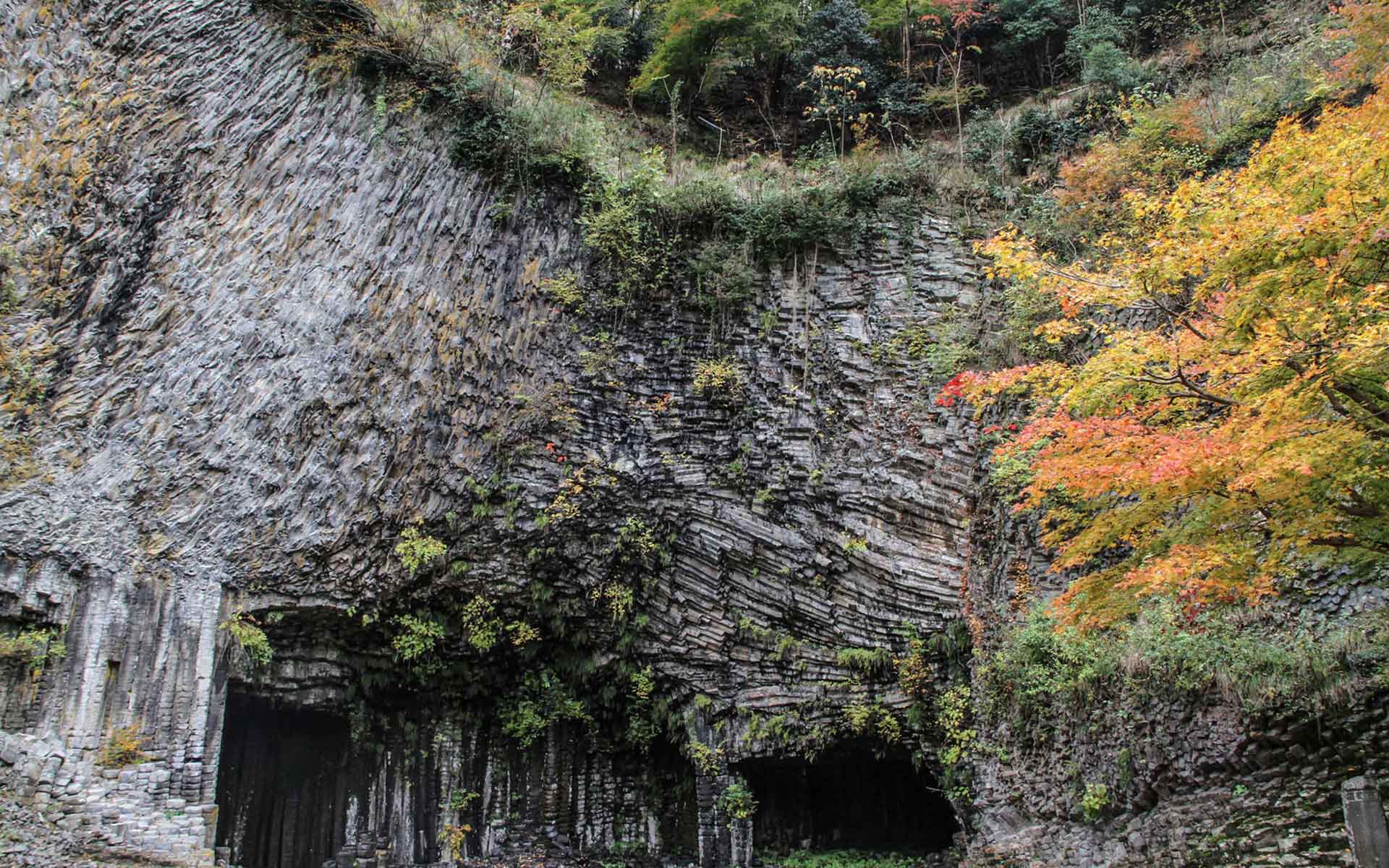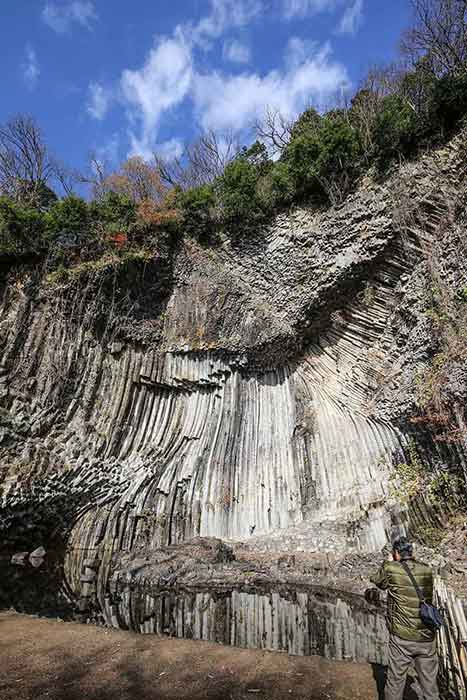
Genbudo and two caves, which are the remnants of digging, where rocks were used for construction against natural disasters but are now preserved as a monument. (Photo: Noritaka Matsubara).
Geological Period
Quaternary / Pleistocene
Main geological interest
History of geosciences
Location
San’in Kaigan Geopark. Hyogo Prefecture. Japan.
35°35’17.0″N, 134°48’18.0″E
Genbudo and two caves, which are the remnants of digging, where rocks were used for construction against natural disasters but are now preserved as a monument. (Photo: Noritaka Matsubara).
Location where geomagnetic reversed polarity was first proposed through studying basalts.
Around 100 years ago, Motonori Matuyama first proposed geomagnetic reversal in Genbudo. This discovery greatly contributed to the subsequent advancement of earth science; for example, ocean-floor paleomagnetic stripes based on magnetic normal and reversed polarity intervals advanced model of plate tectonics in the late 1960s (Vine and Mattherws, 1963). The age of the basalt was determined in 1966, and their geological mapping was completed in 1991. Good exposures in Genbudo Park are quarries worked before the designation of the natural monument. Hexagonal disks of their columns of basalt were used for river banks, fire walls, and house fences. Such findings are useful for educational purposes.
- Geological description
Genbudo is one of the Quaternary Monogenic Basalt volcanoes in central Japan. The lava of Genbudo Cave is 1.61-Ma alkaline basalt (Genbudo Research Group, 1991; Kawai and Hirooka, 1966). It exhibits spectacular columnar jointing reflecting its complex cooling history. In 1926, Dr. Motonori Matuyama discovered that the basalt of Genbudo Cave exhibited magnetic polarity opposite to the present geomagnetic field. This discovery led to the recognition of the presence of a period of the earth’s magnetic field opposite to the present, and in 1929, he proposed “geomagnetic reversal polarity” (Matuyama, 1929). The geomagnetically reversed period, including the age of Genbudo, was named “Matuyama Reversed Chron” in the 1960s, whose start corresponds to the beginning of Quaternary.
Ritsuzan Shibano, a Confucian scholar, visited Genbudo Cave in 1807 and named it Genbudo because he compared the outcrop’s irregularly oriented columnar joints to a Chinese legendary animal, Genbu (black tortoise). In 1884, Koto Bunjiro named the basalt “Genbugan” in Japanese from Genbudo, whose Chinese characters are used also in China. In 1931, Genbudo Caves were designated as a national natural monument. Since then, they have been preserved and managed as educational sites, accessible only for research
- Scientific research and tradition
Matuyama proposed the first geomagnetic reversal polarity approximately 100 years ago. The 2.58–0.774-Ma period was adopted as “Matuyama Reversed Chron” in the 1960s (Cox et al., 1964). The Matuyama Reversal was established as the start of Quaternary (Head et al., 2008).
- Reference
Cox, A., Doell, R.R. and Dalrymple, G.B. (1964) ‘Reversals of the Earth’s Magnetic Field’, Science, 144(3626), pp. 1537–1543. Available at: https://doi.org/10.1126/science.144.3626.1537.
Genbudo Research Group (1991) ‘Geology and petrology of Quaternary volcanic rocks from the Genbudo area, northern Hyogo Prefecture, southwest Japan’, Chikyukagaku, 45, pp. 131–144.
Head, M.J., Gibbard, P. and Salvador, A. (2008) ‘The Quaternary: Its character and definition’, Episodes, 31(2), pp. 234–238. Available at: https://doi.org/10.18814/epiiugs/2008/v31i2/009.
Kawai, N. and Hirooka, K. (1966) ‘Some age dating results of Cenozoic volcanic rocks in the southwest Japan’, in Annual Meeting Geological Society of Japan. 30.
Matuyama, M. (1929) ‘On the Direction of Magnetisation of Basalt in Japan, Tyôsen and Manchuria’, in Proceedings of the Imperial Academy. Tokyo, pp. 203–205. Available at: https://doi.org/10.2183/PJAB1912.5.203.
Vine, F.J. and Matthews, D.H. (1963) ‘Magnetic Anomalies over Oceanic Ridges’, Nature, 199, pp. 947–949. Available at: https://doi.org/10.1038/199947a0.
- Author(s)
Noritaka Matsubara
University of Hyogo/San’in Kaigan Geopark Promotion Council
Yuuki Fujihara
San’in Kaigan Geopark Promotion Council
Setsuya Nakada
The University of Tokyo (presently NIED)


